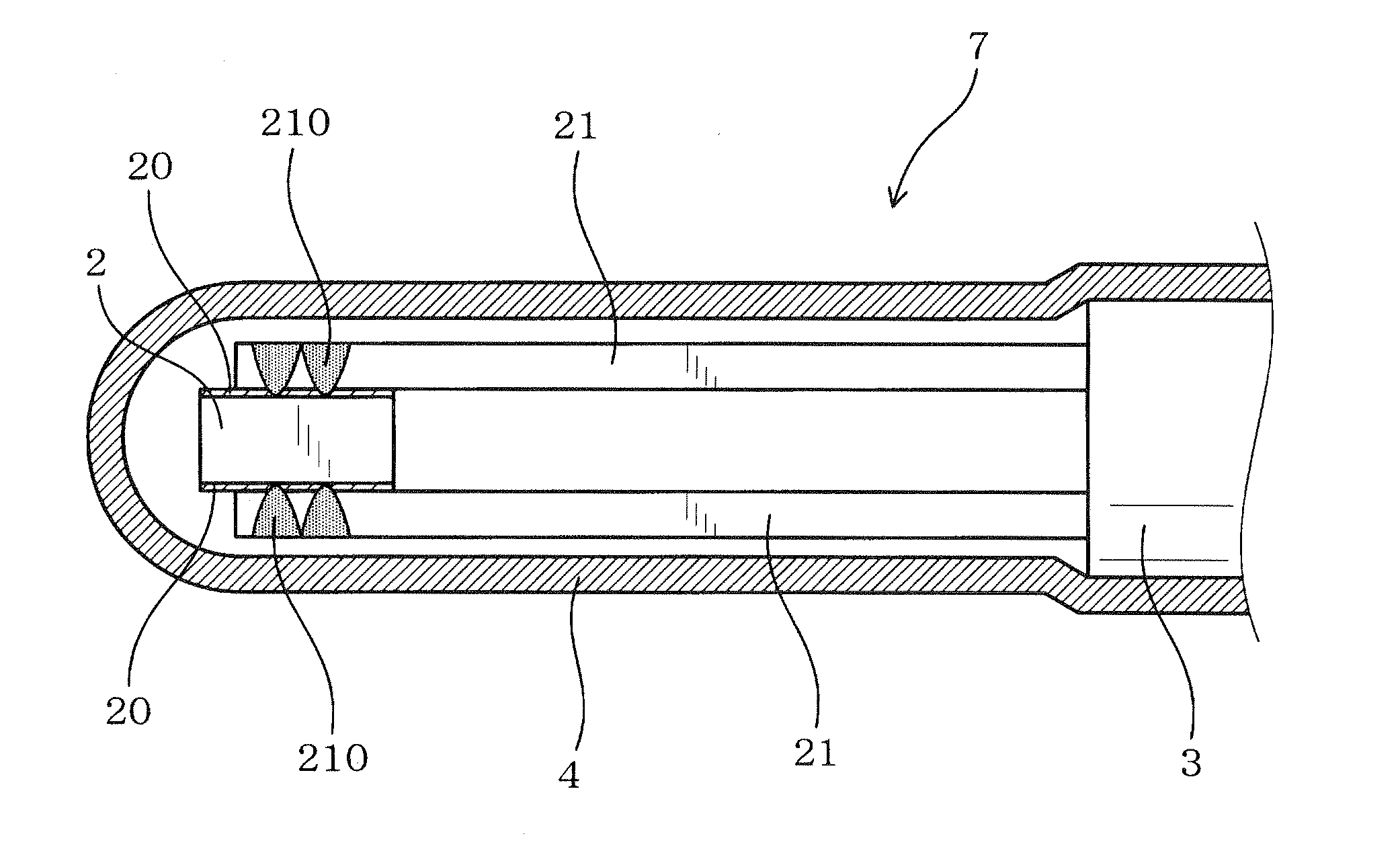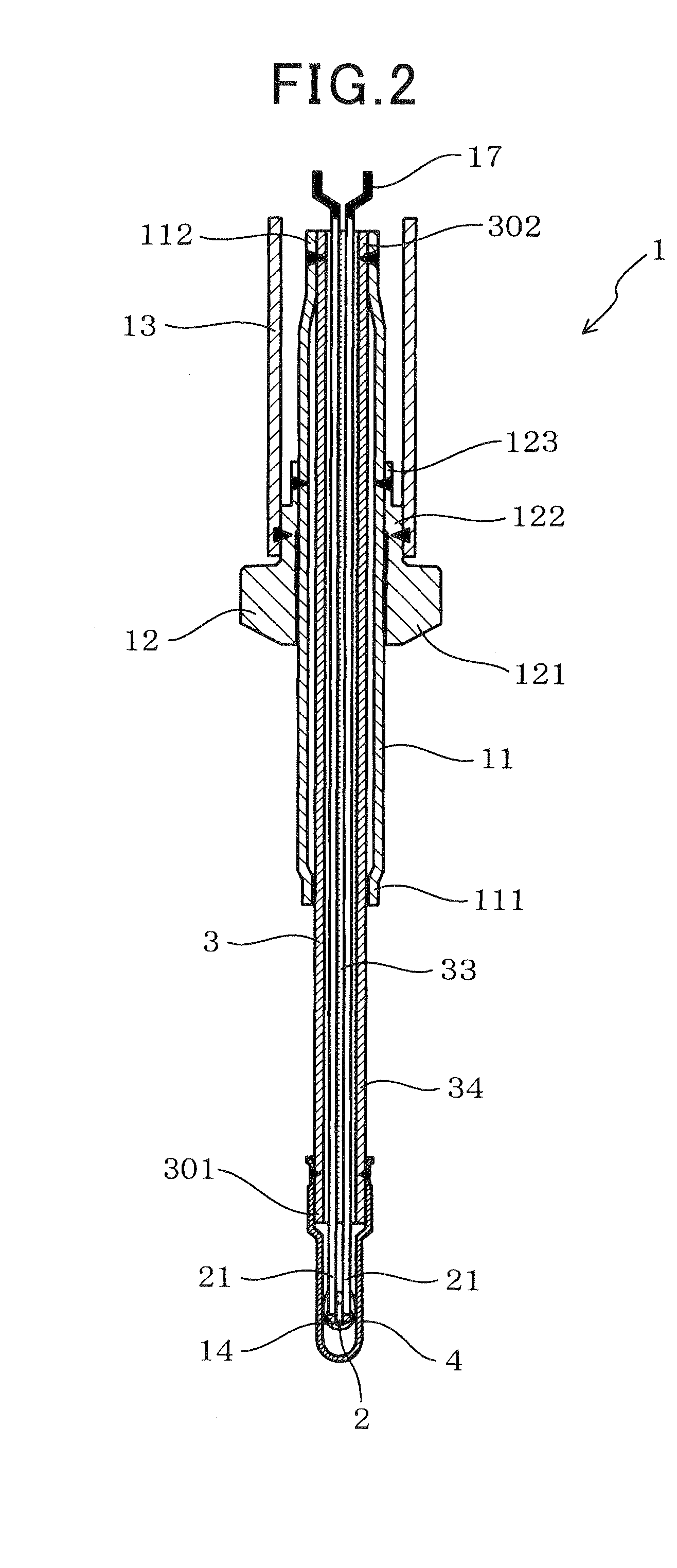Temperature sensor including thermosensitive element
- Summary
- Abstract
- Description
- Claims
- Application Information
AI Technical Summary
Benefits of technology
Problems solved by technology
Method used
Image
Examples
first embodiment
[0073]Next, a temperature sensor according to a first embodiment of the present invention will be described. A temperature sensor 1 according to the present embodiment includes a thermosensitive element 2, a pair of electrode films 20, and a pair of lead wires 21, as shown in FIG. 1 to FIG. 3. The thermosensitive element 2 is composed of a low-thermal expansion ceramics and electrical characteristics thereof change depending on temperature. The pair of electrode films 20 are provided on the surfaces of the thermosensitive element 2. The pair of lead wires 21 are bonded to the pair of electrode films 20 and used for external circuit connection. The lead wires 21 are bonded to the electrode films 20 by a bonding material 22.
[0074]According to the present embodiment, the low-thermal expansion ceramics of the thermosensitive element 2 is configured by a first phase and second-phase particles. The first phase is composed of insulating matrix particles composed of a non-oxide. The second-...
second embodiment
[0116]A temperature sensor according to a second embodiment of the present invention will be described. According to the second and subsequent embodiments, constituent elements that are the same as or equivalent to the constituent elements of the temperature sensor according to the first embodiment, described above, are given the same reference numbers. Descriptions thereof are omitted or simplified.
[0117]According to the present embodiment, an example is given of an instance in which the temperature sensor is manufactured by changing the method of forming the electrode films on the thermosensitive film and the like from that according to the first embodiment. Other than the changes in the method of forming the electrode film and the like, described hereafter, the temperature sensor according to the present embodiment has a similar configuration to that according to the first embodiment.
[0118]Regarding manufacturing of the temperature sensor according to the present embodiment, spec...
third embodiment
[0127]A temperature sensor according to a third embodiment of the present invention will be described with reference to FIG. 7. According to the present embodiment, the present invention is related to a temperature sensor configured such that lead wires bonded to electrode films of a thermosensitive element are bonded to signal wires extending from a sheath pin.
[0128]Specifically, in a temperature sensor 6 according to the present embodiment, in a manner similar to that according to the first embodiment, the rectangular parallelepiped thermosensitive element 2, the pair of electrode films 20, and the lead wires 21 are included, as shown in FIG. 7. The pair of electrode films 20 are provided on the surfaces of the thermosensitive element 2. The lead wires 21 are bonded to the pair of electrode films 20. The lead wires 21 are bonded to the electrode films 20 by the bonding material 22.
[0129]According to the present embodiment, the pair of lead wires 21 bonded to the electrode films 20...
PUM
 Login to View More
Login to View More Abstract
Description
Claims
Application Information
 Login to View More
Login to View More - R&D
- Intellectual Property
- Life Sciences
- Materials
- Tech Scout
- Unparalleled Data Quality
- Higher Quality Content
- 60% Fewer Hallucinations
Browse by: Latest US Patents, China's latest patents, Technical Efficacy Thesaurus, Application Domain, Technology Topic, Popular Technical Reports.
© 2025 PatSnap. All rights reserved.Legal|Privacy policy|Modern Slavery Act Transparency Statement|Sitemap|About US| Contact US: help@patsnap.com



